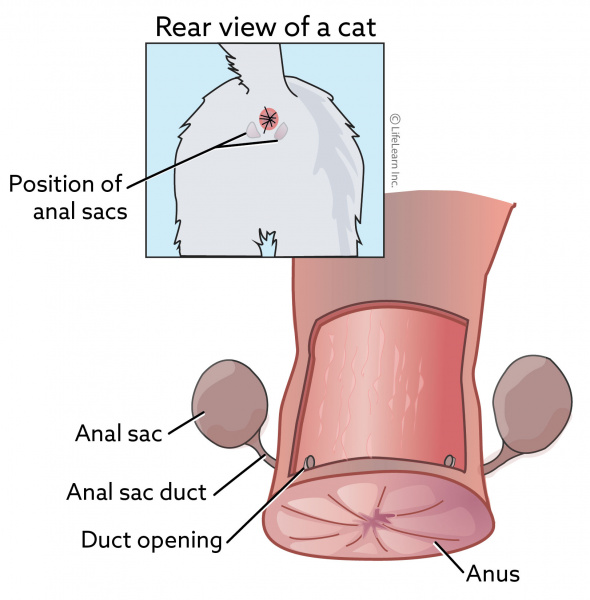Anal Sac Tumors
What are the anal sacs and anal glands?
Dogs and cats have a pair of anal sacs, one located on each side of the anus between the external and internal anal sphincter muscles. The sacs are lined with modified sweat glands called anal glands. The anal glands normally produce foul-smelling, grey-brown, granular secretions, which are stored in the anal sacs.
What is an anal sac tumor?
An anal sac tumor is a tumor of made up of cells originating from the glands of the anal sac. The tumor usually grows quickly and has a moderate rate of spread. One of the biggest problems with anal sac tumors is that they can spread elsewhere in the body. As well, their growing size can make removal difficult. The earlier these tumors can be detected, the better for your pet.
What causes this cancer?
The reason why a particular pet may develop this, or any tumor or cancer, is not straightforward. Very few tumors and cancers have a single known cause. Most seem to be caused by a complex mix of risk factors, some environmental and some genetic or hereditary. There are no known specific causes behind the development of anal gland tumors.
How is this cancer diagnosed?
Typically, these tumors are found incidentally during routine yearly physical examinations. Your veterinarian may see or feel a mass during visual examination of your pet’s hind end or feel a mass during a rectal exam.
If a mass has been detected by your veterinarian, the easiest way to confirm the presence of an anal sac tumor is by a fine needle aspirate. This involves placing a small needle into the mass from the outside of your dog’s hind-end and retrieving cells from the mass. These cells can then be placed on a slide and evaluated by a pathologist. If a sample cannot be obtained by this method, the mass will be removed and sent for review by a pathologist for diagnosis confirmation.
How does this cancer typically progress?
Anal sac tumors have a moderate risk of spread dependent on a multitude of factors. Therefore, your veterinarian will be concerned about both the local disease (the mass itself, or primary tumor) and the potential for spread, or if it has already spread at the time of diagnosis. This becomes important in terms of treatment options and therefore, your pet will have tests performed to stage the tumor prior to any intervention.
Staging means determining if the cancer has spread elsewhere by assessing what period (or stage) of tumor development the tumor is currently in. This usually involves other imaging such as abdominal ultrasound and X-rays. Depending on the results, further sampling may be required, and will ultimately alter the treatment plan.
How will it affect my pet?
Depending on the tumor’s size, your pet could develop signs of straining to defecate or produce ribbon-like stool. Hypercalcemia (an increased calcium level in the blood found on your pet’s blood tests) can be consistent with anal sac tumors. These tumors produce a protein that causes the release of calcium into the bloodstream. Therefore, your pet may show signs of increased drinking, increased urination, and/or lethargy and vomiting. Kidney injury/failure is also possible from persistently high calcium levels.
What are the treatments for this type of tumor?
The best and most well described local treatment for the primary tumor is surgery. This typically involves removal of the mass; however, it is possible cells may be left behind. If staging has found disease elsewhere (for example, if a lymph node contains abnormal tumor cells), that area will typically be surgically removed as well. Chemotherapy may then be considered if there is evidence of spread. If surgery is not an option, your veterinarian may discuss with you the options for radiation therapy on a case-by-case basis.
Is there anything else I should know?
If your pet is having difficulty defecating or is straining to defecate as a result of an anal sac mass, your veterinarian may recommend a stool softener to relieve your pet of this discomfort until treatment can be pursued. It is therefore best to avoid diets that will cause bulkiness to the stool (e.g., high fiber diets).
The mass may be uncomfortable and therefore your pet should not be allowed to scoot or lick their hind end. In pets that have an elevated calcium, they should always have access to plenty of fresh water until treatment can be pursued.






